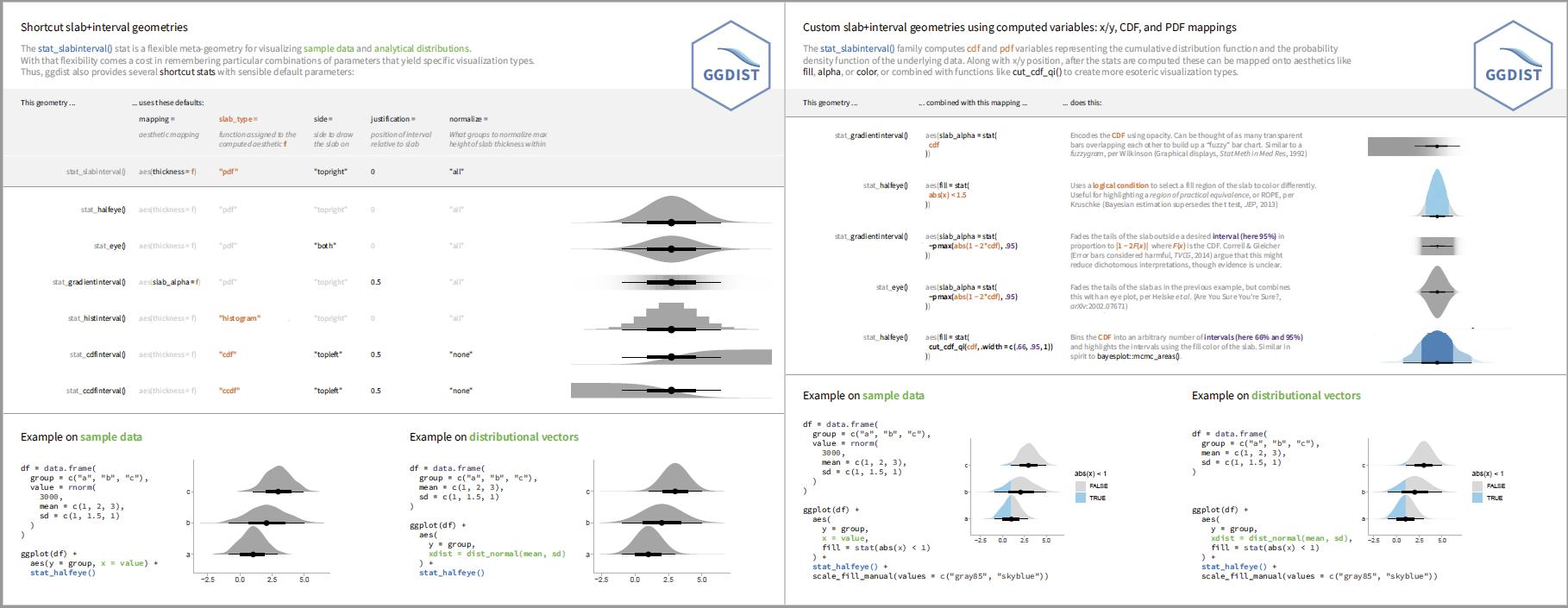ggdist is an R package that provides
a flexible set of ggplot2 geoms and stats designed especially for
visualizing distributions and uncertainty. It is designed for both
frequentist and Bayesian uncertainty visualization, taking the view that
uncertainty visualization can be unified through the perspective of
distribution visualization: for frequentist models, one visualizes
confidence distributions or bootstrap distributions (see
vignette("freq-uncertainty-vis")); for Bayesian models, one visualizes
probability distributions (see the
tidybayes package, which builds
on top of ggdist).
The geom_slabinterval() / stat_slabinterval() family (see
vignette("slabinterval")) makes it easy to visualize point summaries
and intervals, eye plots, half-eye plots, ridge plots, CCDF bar plots,
gradient plots, histograms, and more:
The geom_dotsinterval() / stat_dotsinterval() family (see
vignette("dotsinterval")) makes it easy to visualize dot+interval
plots, Wilkinson dotplots, beeswarm plots, and quantile dotplots (and
combined with half-eyes, composite plots like rain cloud plots):
The geom_lineribbon() / stat_lineribbon() family (see
vignette("lineribbon")) makes it easy to visualize fit lines with an
arbitrary number of uncertainty bands:
All stat in ggdist also support visualizing analytical distributions
and vectorized distribution data types like
distributional
objects or posterior::rvar() objects. This is particularly useful when
visualizing uncertainty in frequentist models (see
vignette("freq-uncertainty-vis")) or when visualizing priors in a
Bayesian analysis.
The ggdist geoms and stats also form a core part of the
tidybayes package (in fact, they
originally were part of tidybayes). For examples of the use of
ggdist geoms and stats for visualizing uncertainty in Bayesian models,
see the vignettes in tidybayes, such as
vignette("tidybayes", package = "tidybayes") or
vignette("tidy-brms", package = "tidybayes").
You can install the currently-released version from CRAN with this R command:
install.packages("ggdist")Alternatively, you can install the latest development version from GitHub with these R commands:
install.packages("devtools")
devtools::install_github("mjskay/ggdist")I welcome feedback, suggestions, issues, and contributions! I am not
particularly reliable over email, though you can contact me at
[email protected]. On Twitter I am
more reliable. If you have found a bug, please file it
here with minimal code to
reproduce the issue. Pull requests should be filed against the
dev branch.
Matthew Kay (2022). ggdist: Visualizations of Distributions and Uncertainty. R package version 3.2.0, https://mjskay.github.io/ggdist/. DOI: 10.5281/zenodo.3879620.





